
Wine Culture and Information since 2002 - Volume 22
 Wine Culture and Information since 2002 - Volume 22 |
|
Issue 217, May 2022 |
Contents |
|
|
What If Wine Should Change? |
|
Nothing is forever. Time goes by, things change – and with them, also the events and habits of humans – usually forced to adapt themselves to new conditions and needs. Furthermore, change is often imperative to ensure that everything remains as it was before. Something that, notoriously, was also suggested in the magnificent masterpiece “The Leopard” by Giuseppe Tomasi di Lampedusa: «If we want everything to stay as it is, everything has to change». After all, whoever fears the future, therefore change, is condemned to regret the past, fearing the present, excluded from the time that will be. However, those who allow themselves to the future by forgetting the experience of the past and the fruit of the present, are inevitably doomed to the unfortunate misfortune of repeating their mistakes – without ever understanding the cause – prisoner of a failed regression devoid of any hope. Moreover, it is also true that history teaches men nothing – or very little – with ignoble and deplorable effects for the future, blinded only by their own useless arrogance and the presumption of believing that the future must necessarily be the obstinate repetition of the mistakes of the past. Repetiva iuvant, (repeated things help) says a famous Latin saying, however, if we closely look at the obstinate repetition of certain things in the future, it would not seem to help that much, indeed. Then, it is also true that, in certain cases, the actions and events of the future – even the absolutely new and unprecedented ones – turn out to be unsuccessful and not convenient at all, forcing, so to speak, to go back and start over from the past, strengthened by the experience gained from the mistakes just made, possibly avoiding repeating them. Wine, of course, is not immune to the events following one another over time, from dealing with its past, including looking to the future. Not least, to go back to the past and remain anchored to that era, that style, unquestionably elected as the future of wine, simply perpetuating the very same time and ways that are anything but progress. This happens not only for wine, especially in those countries – like Italy – so strongly rooted to the past and to their traditions, often considered as sacred, even inviolable and immutable, perhaps also for the fear of facing the future, one's own future. In these times, so bizarre, so remotely unimaginable only three years ago, wine – after having achieved, at least in Italy, a sensational result in economic and trade terms – is preparing to face the near future with some difficulties and uncertainty. Not only those that are being determined by the new economic conditions on a global level, but also – and above all – by the situation that is being created in the production and availability of raw materials. At the moment, producers are most concerned about the scarce availability of bottles, a fundamental good for the marketing of wine. Without the glass bottle, the wine remains in the casks and tanks, unable to leave the winery for the consumers' glasses. This is – of course – an obstacle that is not exactly simple, given the implications that this entails in the entire wine sector and, more generally, in any production sector requiring glass and the bottle as indispensable elements. The bottles available on the market – that is the basic material, therefore empty – have either been purchased in recent months and in large batches from large wineries with enormous financial resources and negotiating potentials, or, those available, are sold to high prices. In the second hypothesis, in case the producer manages to buy them – both for opportunity and for economic possibility – this translates directly into an increase in production costs, therefore in the final selling price. Furthermore, the problem is not only the glass for the bottles, but also the other raw materials and services that – as a whole – allow the producer to “finish” the product and sell it. However, according to what has been declared by the producers on several recent occasions, it would precisely be the difficulty in finding glass bottles to make wine trading critical. What if the simplest solution was to replace glass with another material, possibly at this moment easier to find and which, as a primary condition, guarantees the good keeping of the wine until it is poured into the glass? I already imagine, in truth, the perplexed and perhaps even indignant reaction of many in thinking of pouring wine into their glasses from something other than a glass bottle. It is – I imagine for many – a change also of a cultural nature and not only linked to the immovable sacredness of tradition, because this has always been so and it must not change. Nevertheless, before glass was “invented”, wine was marketed and shipped everywhere, transported in containers produced with the materials available at the time. Yes, of course, glass is an excellent material in this sense, much better – for example – than the terracotta amphorae that were used at the dawn of Western civilizations. However, what should we do if glass bottles aren't so readily available? Should we stop making and marketing wine? After all, to be honest, we have already seen a “cultural” change of this type and, many will remember, aroused quite a lot of controversies, including the indignation of many, shouting scandal and acting as irreducible bulwarks in defense of tradition and of “because this has always been like so, this is how it must be forever”. I am referring to what happened to closures, when those produced with synthetic materials, as well as glass or screw caps, began to be used. At first – and I remember it all too well – it was an exaggerated ruckus, then, with time, the novelty was accepted and today very few notice the fact that, when opening a bottle, they end up having a synthetic or screw cap in their hands. Not only that: this novelty has allowed considerable cost savings, allocating the use of the best corks to wines that really require them and for which – at least for the moment – it is irreplaceable. A change that, despite having challenged the sacred tradition, today it is an accepted fact. After all, what is tradition if not a successful event and which, as such, is perpetuated over time? And how many events of the past have not become part of the tradition just because they have proved to be unsuccessful? I am aware the proposal of replacing the glass bottle with another container and made with a different material is a provocation, certainly annoying for many. Don't worry about this: replacing the glass bottle with another container is not so simple. First of all, it would be necessary to change all the production disciplinary of denomination wines as the glass bottle is expressly a requirement provided by law. And, as a matter of fact, a wine disciplinary is a law of the Italian State in all respects. Given the current situation, for which it is difficult – at this moment – to predict when a recovery will occur, it is probably necessary to think about functional alternatives. The glass bottle – exactly as for natural cork – turns out to be indispensable, therefore irreplaceable, for certain wine styles, such as those destined for long aging. Wines to be consumed after a few months or years from production can certainly be marketed in containers other than glass, probably even cheaper. Everything changes: it is just a matter of time and adaptation. Just like for “non-cork” caps, sooner or later even “non-glass” bottles will become commonplace and accepted. A matter of time and, perhaps, they could not even be bottles. After all, what makes a wine good and appreciable is what we pour into the glass, exactly at that moment when we forget about the glass bottle or whatever it is. Antonello Biancalana
|
||||
Contrasts of Moscato di Sardegna Passito and Aleatico di Puglia PassitoWines produced with dried grapes express much more than just sweetness. Concentrates of substances and flavors, extraordinary treasures of complex and persuasive aromas, always represent a sensorial exercise of considerable value. |
|
The wine market of every wine-growing country in the world is strongly dominated by the so-called “dry” table wines – white, red and rosé – followed by sparkling wines. In some territories, this condition is exactly the opposite, with bubbles representing the prevalent production, frequently the only one. In the last place, with very rare exceptions, we always find sweet wines from dried grapes, whether they are “natural sweet” (that is without adding any wine spirit) or fortified (to which, instead, wine spirit is added). The current situation is clearly opposite to that of the past, when the majority of wines belonged to the category that today we call sweet from dried grapes. This kind of wines, in fact, had the favor of consumption in past times, not least, it was the result of common wine making practices of the past, as well as a fermentation not completely carried out due to environmental and technological conditions, including the taste of out ancestors. Sweet wines from dried grapes of the past and “modern” ones still share two qualities: they are very expensive to make and are characterized by complex and very rich organoleptic profiles. The production of a sweet wine from high quality dried grapes is a decidedly expensive process, if compared with other styles of wines, both because it requires very high qualitative factors, and because of the very low yield of the grapes. It must be noticed, in fact, the yield in must of dried grapes – depending on the type of wine to be produced and quality – can be as little as 30%. The drying process obviously involves a conspicuous loss of water inside the berries, with a consequent concentration of other substances, in particular, sugars. The two wines we will examine in the tasting by contrast of this month are no exception to this, which differ, not only for the geographical origin, but also for the color of the grapes. Moscato di Sardegna Passito, in fact, is produced with Muscat Blanc, while Aleatico di Puglia Passito with the homonymous grape, notoriously red berried.
|
|
Muscat Blanc is one of the oldest known varieties, always appreciated both as a table grape and for the production of wines. Variety that has always fascinated men, both for the marked sweetness and for the finesse of its aromas, a heritage – the latter – that is always expressed in its wines. Muscat Blanc is virtually found in every wine-growing country in the world, often used for the production of “late harvest” wines and, above all, sweet wines from dried grapes. The latter style seems to be very appropriate for Muscat Blanc, a quality testified not only by the history of this grape, but above all by the finesse and balance of its wines. Muscat Blanc was widely known and appreciated since the times of the ancient Romans, often identified with the name of uva apiana, because of the strong predilection of bees (ape is Italian for bee) for the sweetness of its berries. The charm of wines produced with this grape, not only in the sweet style from dried grapes, is still alive today, enjoying the favor of consumers everywhere. The presence of Muscat Blanc in Sardinia boasts a long and widely documented history, its spreading on the island mainly started during the period of Piedmontese administration in the 1700s. Muscat Blanc is now used in some appellation wines of Sardinia, among them Cagliari Moscato, Moscato di Sorso-Sennori and Moscato di Sardegna. The latter is produced in the entire territory of the island and includes the sub-denominations “Tempio Pausania” or “Tempio” and “Gallura”, provided for the sparkling wine style only. Moscato di Sardegna – the wine we are considering for our tasting – involves the production of the white, passito, overripe and sparkling wine styles, all produced with at least 90% Muscat Blanc and any 10% of white grapes allowed for cultivation in Sardinia. The production of Moscato di Sardegna Passito is often carried out through the use of inert containers, in particular the steel tank, with the aim of preserving both the aromatic finesse of the grapes and the acidity, this latter quality essential for getting a perfect sensorial balance. In this regard, it should in fact be noted Moscato di Sardegna must have a minimum natural alcohol content of 16%, a characteristic which, coupled to the marked sweetness of the sugars, requires adequate acidity in order to get balance.
|
||||
|
Aleatico is a red berried variety of considerable interest, widespread in many regions of Italy and with a long history. For this grape, in fact, we can speak about history but not exactly of origins, as – still today – these are unclear and subject of many hypotheses. Pier De 'Crescenzi, at the beginning of the 1300s, claimed the origin of Aleatico was Tuscany, reporting that, at that time, it was already widespread in the region and known as Livatica. Cosimo Trinci had a totally different opinion, who – in 1726 – claimed Aleatico had been introduced in Apulia by the Greeks. To support this hypothesis, the famous agronomist claimed that it was in fact the Liatiko grape, grown in Crete. Over time, other hypotheses have been formulated, however, none of them has a proven foundation, including the alleged kinship with the Liatiko variety, which turned out to be totally different. However, Aleatico boasts numerous historical testimonies of appreciation for its wines, reporting its presence in various Italian regions, including Apulia. More recent studies conducted by Manna Crespan and Nicoletta Milani have shown that Aleatico is closely related to Muscat Blanc, a characteristic that would justify its intense aroma. Furthermore, this study would seem to support the hypothesis of the famous botanist Giorgio Gallesio, who supported the idea Liatica or Livatica grape – name with which Aleatico was known at his time – derived from Muscats by seed propagation. Giuseppe Di Rovasenda also claimed that in certain areas of Italy, Aleatico was known as Moscatello Nero and Moscato Nero, thus associating its origin with the famous family of aromatic grapes. The presence of Aleatico in Apulia is rooted in the entire regional territory and for almost fifty years it has been recognized as a wine with a Denomination of Controlled Origin (Denominazione d'Origine Controllata, DOC). The production disciplinary provides for the natural sweet, fortified natural sweet and reserve styles, in which the presence of Aleatico must be at least 85%, while the remaining part can be completed by Negroamaro, Malvasia Nera and Primitivo.
|
|
Before proceeding with this month's tasting by contrast, let's find the two bottles that we will pour into the glasses. In this regard, it should be noted these are two wines with relatively low production, therefore not very widespread, a characteristic often distinguishing all sweet wines from dried grapes. When choosing Moscato di Sardegna Passito and Aleatico di Puglia Passito we will pay attention to their composition, making sure that they are exclusively produced with the two reference varieties. It must in fact be noticed that, in both cases and according to the respective production disciplinary, both Moscato Bianco and Aleatico can be present for a quota of less than 100%, in any case for a minimum of 85%. As far as production and vinification are concerned, with the aim of allowing the maximum expression of the two varieties – characterized by appreciable aromaticity – we will choose two wines fermented and aged in inert containers, such as the steel tank. Moscato di Sardegna Passito and Aleatico di Puglia Passito are poured into their respective tasting glasses: the Sardinian wine at a temperature of 14 °C (58 °F), the Apulian wine at 16 °C. (61 °F)
Let's pour Moscato di Sardegna Passito and Aleatico di Puglia Passito into their respective tasting glasses and start the comparison, starting with the evaluation of the appearance of the Sardinian wine. Let's tilt the glass of Moscato di Sardegna Passito over a white surface and observe the base. The color is bright and intense amber yellow, while the transparency – evaluated by placing an object between the glass and the white surface – is quite high, allowing a good vision. Let's now evaluate the nuance and observe the wine towards the opening of the glass, at the point where it becomes thinnest. We will note a bright amber yellow color, therefore confirming the base hue. Let's now pass to the evaluation of Aleatico di Puglia Passito and tilt the glass over the white surface. The color is clearly very different from the previous wine: we note an intense and brilliant ruby red, with a moderate transparency, sometimes even low. The nuance of Aleatico di Puglia Passito – observed at the edge of the glass, near its opening – reveals an intense ruby red, sometimes tending to garnet red. Wines produced with Muscat Blanc and Aleatico express pleasing aromas to the nose that directly recall grape juice, and this is the only characteristic these two grapes have in common. Moscato di Sardegna Passito expresses to the nose, in addition to the intense scent of dried grapes, aromas of dried apricot, candied fruit, peach and quince jam, date, dried fig, almond, citrus peel and pleasing hints of exotic fruit, in particular lychee. There is, of course, a good expression of fragrances that can be associated to the world of flowers, including lavender and yellow rose. The olfactory profile of Aleatico di Puglia Passito is clearly no less exciting and, as already mentioned, it expresses to the nose an intense aroma of dried grapes. Wines produced with this grape can be recognized for the rich expression of aromas associated to red and black fruit, in particular, cherry, raspberry, strawberry, blueberry, blackberry and plum. The world of flowers is also richly represented in wines produced with Aleatico passito, in particular rose, violet and cyclamen. Furthermore, it is often possible to perceive aromas of cinnamon, pink pepper and anise. Let's resume our tasting by contrast and proceed with the analysis of the olfactory profiles of Moscato di Sardegna Passito and Aleatico di Puglia Passito, starting – as for the previous phase – with the Sardinian wine. Let's proceed with the first smell in order to evaluate the opening of this wine, that is the identifying aromas emerging from the glass, held in a vertical position and without swirling. To the nose can be perceived intense, clean and pleasing aromas of raisins, dried apricot and quince jam, as well as dried rose and lavender. Let's now swirl the glass – an operation favoring the development of the remaining aromas – and do the second smell. The olfactory profile of Moscato di Sardegna Passito is completed with candied fruit, dried fig, citrus peel, peach jam, date, honey, almond, caramel, sage and thyme. Let's pass to the evaluation of the opening of Aleatico di Puglia Passito and – by holding the glass in vertical position – let's do the first smell. From the glass can be perceived intense, clean and refined aromas of raisins, cherry, raspberry and strawberry, as well as floral notes of rose and violet. After having swirled the glass and carried out the second smell, the olfactory profile of the Apulian wine is completed with blueberry, blackberry, plum, cinnamon, anise and a pleasing hint of pink pepper. Let's now pass to the evaluation of the gustatory profiles of the two wines of our tasting by contrast, taking into consideration Moscato di Sardegna Passito. The first gustatory characteristic we will evaluate is the attack, that is the primary sensations perceived in the mouth at the initial sip. The first quality perceived in the Sardinian wine is a marked sweetness, in addition to the pleasing roundness, immediately followed by the pseudo-caloric sensation of alcohol. The balance of the wine is readily reached with the effect of acidity, essential to reduce the excessive impact of sweetness in the mouth. We also perceive the flavors of raisins, dried apricots, peach jam, dates and honey, confirming the excellent correspondence to the nose. Let's now take a sip of Aleatico di Puglia Passito and evaluate the attack. Also in this case the initial sensation perceived in the mouth is sweetness, followed by the appreciable roundness and the effect of alcohol. These qualities find perfect balance both in the acidity and in the astringency of the wine, the latter decidedly moderate, however pleasing and well integrated with the gustatory profile of the wine. In the mouth, moreover, we perceive the flavors of grape, raspberry, cherry, strawberry and blackberry. Let's conclude this month's tasting by contrast by evaluating the final sensations the two wines leave in the mouth, among them, the taste-olfactory persistence. The finish of Moscato di Sardegna Passito is very persistent, leaving in the mouth pleasing sensations of sweetness that still find their balance in the effect of the crispness given by the acidity. You can also perceive flavors of raisins, dried apricots, dried figs and honey. The sensation of structure is also still well perceptible. The finish of Aleatico di Puglia Passito is equally persistent and in the mouth we continue to perceive both sweetness and roundness, as well as the acidity and the gentle astringency contributed by tannins. The wine also leaves in the mouth pleasing and intense flavors of grape, cherry, raspberry, strawberry and blackberry. The sensations of structure of the two wines should be carefully evaluated: although Moscato di Sardegna Passito expresses good body, the one of Aleatico di Puglia Passito is decidedly fuller, also thanks to the effect of tannins.
|
||||||||
Wines of the Month |
|
|
|
Score legend Prices are to be considered as indicative. Prices may vary according to the country or the shop where wines are bought |
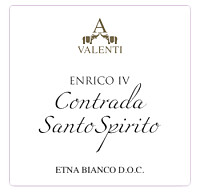
|
|
Etna Bianco Enrico IV Contrada Santo Spirito 2018 |
|
| Valenti (Sicily, Italy) | |
 Carricante Carricante | |
| Price: € 19.00 | Score: |
 Brilliant straw yellow and nuances of straw yellow, very transparent. Brilliant straw yellow and nuances of straw yellow, very transparent. Intense, clean, pleasing, refined and elegant, starts with hints of
apple, plum and grapefruit followed by aromas of hawthorn, broom, pear,
mango, pineapple, peach, mint, vanilla and mineral. Intense, clean, pleasing, refined and elegant, starts with hints of
apple, plum and grapefruit followed by aromas of hawthorn, broom, pear,
mango, pineapple, peach, mint, vanilla and mineral.
 Crisp attack and however balanced by alcohol, good body, intense
flavors, pleasing roundness. Crisp attack and however balanced by alcohol, good body, intense
flavors, pleasing roundness.
 Persistent finish with flavors of apple, plum and grapefruit. Persistent finish with flavors of apple, plum and grapefruit. 6 months in barrique, 3 months in bottle. 6 months in barrique, 3 months in bottle. |
|
 Pasta with fish, Mushroom soups, Stewed fish with mushrooms, Stewed white meat, Dairy products Pasta with fish, Mushroom soups, Stewed fish with mushrooms, Stewed white meat, Dairy products |
|
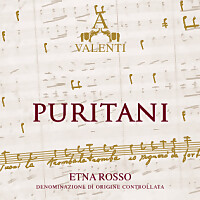
|
|
Etna Rosso Puritani 2014 |
|
| Valenti (Sicily, Italy) | |
 Nerello Mascalese Nerello Mascalese | |
| Price: € 19.00 | Score: |
 Brilliant ruby red and nuances of brick red, moderate transparency. Brilliant ruby red and nuances of brick red, moderate transparency. Intense, clean, pleasing, refined and elegant, starts with hints of
cherry, raspberry and plum followed by aromas of dried violet, dried rose,
strawberry, cinnamon, cocoa, tobacco, leather, licorice, vanilla and
menthol. Intense, clean, pleasing, refined and elegant, starts with hints of
cherry, raspberry and plum followed by aromas of dried violet, dried rose,
strawberry, cinnamon, cocoa, tobacco, leather, licorice, vanilla and
menthol.
 Properly tannic attack and however balanced by alcohol, good body,
intense flavors, pleasing crispness. Properly tannic attack and however balanced by alcohol, good body,
intense flavors, pleasing crispness.
 Persistent finish with flavors of cherry, raspberry and plum. Persistent finish with flavors of cherry, raspberry and plum. 20 months in cask, 12 months in bottle. 20 months in cask, 12 months in bottle. |
|
 Broiled meat and barbecue, Roasted meat, Stewed meat with mushrooms, Cheese Broiled meat and barbecue, Roasted meat, Stewed meat with mushrooms, Cheese |
|
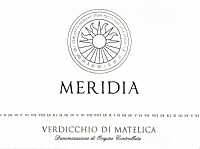
|
|
Verdicchio di Matelica Meridia 2018 |
|
| Belisario (Marches, Italy) | |
 Verdicchio Verdicchio | |
| Price: € 17.00 | Score: |
 Intense straw yellow and nuances of straw yellow, very transparent. Intense straw yellow and nuances of straw yellow, very transparent. Intense, clean, pleasing and refined, starts with hints of apple, plum
and hawthorn followed by aromas of broom, peach, pear, medlar, citrus
fruits, anise, almond and mineral. Intense, clean, pleasing and refined, starts with hints of apple, plum
and hawthorn followed by aromas of broom, peach, pear, medlar, citrus
fruits, anise, almond and mineral.
 Crisp attack and however balanced by alcohol, good body, intense
flavors, agreeable. Crisp attack and however balanced by alcohol, good body, intense
flavors, agreeable.
 Persistent finish with flavors of apple, plum and peach. Persistent finish with flavors of apple, plum and peach. 24 months in cement tanks. 24 months in cement tanks. |
|
 Stuffed pasta, Roasted white meat, Roasted fish, Broiled fish Stuffed pasta, Roasted white meat, Roasted fish, Broiled fish |
|
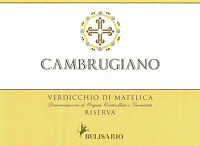
|
|
Verdicchio di Matelica Riserva Cambrugiano 2018 |
|
| Belisario (Marches, Italy) | |
 Verdicchio Verdicchio | |
| Price: € 19.00 | Score: |
 Intense straw yellow and nuances of golden yellow, very transparent. Intense straw yellow and nuances of golden yellow, very transparent. Intense, clean, pleasing, refined and elegant, starts with hints of
apple, plum and hawthorn followed by aromas of broom, chamomile, pear,
peach, pineapple, medlar, grapefruit, honey, rosemary, vanilla and mineral. Intense, clean, pleasing, refined and elegant, starts with hints of
apple, plum and hawthorn followed by aromas of broom, chamomile, pear,
peach, pineapple, medlar, grapefruit, honey, rosemary, vanilla and mineral.
 Crisp attack and however balanced by alcohol, good body, intense
flavors, pleasing roundness. Crisp attack and however balanced by alcohol, good body, intense
flavors, pleasing roundness.
 Very persistent finish with long flavors of apple, plum and almond. Very persistent finish with long flavors of apple, plum and almond. 12 months in steel tanks, a small part 12 months in barrique. 12 months in steel tanks, a small part 12 months in barrique. |
|
 Stuffed pasta, Roasted fish, Roasted white meat, Mushroom soups Stuffed pasta, Roasted fish, Roasted white meat, Mushroom soups |
|

|
|
Titolo Pink Edition 2020 |
|
| Elena Fucci (Basilicata, Italy) | |
 Aglianico Aglianico | |
| Price: € 25.00 | Score: |
 Intense cherry pink and nuances of cherry pink, transparent. Intense cherry pink and nuances of cherry pink, transparent. Intense, clean, pleasing and refined, starts with hints of cherry,
strawberry and raspberry followed by aromas of rose, cyclamen, blueberry,
tangerine, apple, peach and plum. Intense, clean, pleasing and refined, starts with hints of cherry,
strawberry and raspberry followed by aromas of rose, cyclamen, blueberry,
tangerine, apple, peach and plum.
 Crisp attack and however balanced by alcohol, good body, intense
flavors, agreeable. Crisp attack and however balanced by alcohol, good body, intense
flavors, agreeable.
 Persistent finish with flavors of cherry, raspberry and strawberry. Persistent finish with flavors of cherry, raspberry and strawberry. 3 months in steel tanks, 2 months in bottle. 3 months in steel tanks, 2 months in bottle. |
|
 Pasta with meat and mushrooms, Mushroom and legume soups, Roasted white meat, Roasted fish Pasta with meat and mushrooms, Mushroom and legume soups, Roasted white meat, Roasted fish |
|

|
|
Aglianico del Vulture Titolo 2019 |
|
| Elena Fucci (Basilicata, Italy) | |
 Aglianico Aglianico | |
| Price: € 32.00 | Score: |
 Intense ruby red and nuances of ruby red, little transparency. Intense ruby red and nuances of ruby red, little transparency. Intense, clean, pleasing, refined and elegant, starts with hints of
plum, blackberry and black cherry followed by aromas of violet, geranium,
blueberry, raspberry, tobacco, chocolate, carob, rosemary, graphite,
vanilla and menthol. Intense, clean, pleasing, refined and elegant, starts with hints of
plum, blackberry and black cherry followed by aromas of violet, geranium,
blueberry, raspberry, tobacco, chocolate, carob, rosemary, graphite,
vanilla and menthol.
 Properly tannic attack and however balanced by alcohol, full body,
intense flavors, pleasing crispness. Properly tannic attack and however balanced by alcohol, full body,
intense flavors, pleasing crispness.
 Very persistent finish with long flavors of plum, blackberry and black
cherry. Very persistent finish with long flavors of plum, blackberry and black
cherry.
 12 months in barrique, 12 months in bottle. 12 months in barrique, 12 months in bottle. |
|
 Game, Roasted meat, Stewed and braised meat, Hard cheese Game, Roasted meat, Stewed and braised meat, Hard cheese |
|
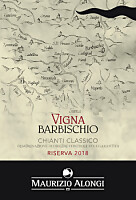
|
|
Chianti Classico Riserva Vigna Barbischio 2018 |
|
| Maurizio Alongi (Tuscany, Italy) | |
 Sangiovese (94%), Malvasia Nera (4%), Canaiolo Nero (2%) Sangiovese (94%), Malvasia Nera (4%), Canaiolo Nero (2%) | |
| Price: € 25.00 | Score: |
 Intense ruby red and nuances of ruby red, little transparency. Intense ruby red and nuances of ruby red, little transparency. Intense, clean, pleasing, refined and elegant, starts with hints of
black cherry, plum and violet followed by aromas of rose, raspberry,
blueberry, blackberry, strawberry, chocolate, cinnamon, tobacco, vanilla
and menthol. Intense, clean, pleasing, refined and elegant, starts with hints of
black cherry, plum and violet followed by aromas of rose, raspberry,
blueberry, blackberry, strawberry, chocolate, cinnamon, tobacco, vanilla
and menthol.
 Properly tannic attack and however balanced by alcohol, good body,
intense flavors, agreeable. Properly tannic attack and however balanced by alcohol, good body,
intense flavors, agreeable.
 Persistent finish with flavors of black cherry, plum and raspberry. Persistent finish with flavors of black cherry, plum and raspberry. At least 12 months in cask, at least 18 months in bottle. At least 12 months in cask, at least 18 months in bottle. |
|
 Broiled meat and barbecue, Roasted meat, Stewed meat with mushrooms, Cheese Broiled meat and barbecue, Roasted meat, Stewed meat with mushrooms, Cheese |
|
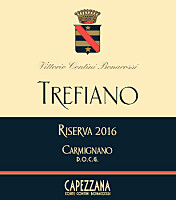
|
|
Carmignano Riserva Trefiano 2016 |
|
| Tenuta di Capezzana (Tuscany, Italy) | |
 Sangiovese (80%), Cabernet Sauvignon (10%), Canaiolo Nero (10%) Sangiovese (80%), Cabernet Sauvignon (10%), Canaiolo Nero (10%) | |
| Price: € 41.00 | Score: |
 Intense ruby red and nuances of garnet red, little transparency. Intense ruby red and nuances of garnet red, little transparency. Intense, clean, pleasing, refined and elegant, starts with hints of
plum, black cherry and dried violet followed by aromas of black currant,
blueberry, blackberry, carob, tobacco, cocoa, licorice, leather, thyme,
vanilla and menthol. Intense, clean, pleasing, refined and elegant, starts with hints of
plum, black cherry and dried violet followed by aromas of black currant,
blueberry, blackberry, carob, tobacco, cocoa, licorice, leather, thyme,
vanilla and menthol.
 Properly tannic attack and however balanced by alcohol, full body,
intense flavors, agreeable. Properly tannic attack and however balanced by alcohol, full body,
intense flavors, agreeable.
 Very persistent finish with long flavors of plum, black cherry and
black currant. Very persistent finish with long flavors of plum, black cherry and
black currant.
 18 months in cask, at least 12 months in bottle. 18 months in cask, at least 12 months in bottle. |
|
 Game, Roasted meat, Stewed and braised meat, Hard cheese Game, Roasted meat, Stewed and braised meat, Hard cheese |
|
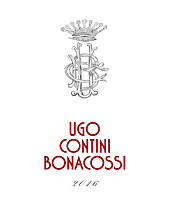
|
|
Ugo Contini Bonacossi 2016 |
|
| Tenuta di Capezzana (Tuscany, Italy) | |
 Sangiovese Sangiovese | |
| Price: € 50.00 | Score: |
 Intense ruby red and nuances of garnet red, little transparency. Intense ruby red and nuances of garnet red, little transparency. Intense, clean, pleasing, refined and elegant, starts with hints of
plum, black cherry and dried violet followed by aromas of dried rose,
blackberry, raspberry, blueberry, cocoa, licorice, tobacco, cinnamon,
leather, cigar box, mace, vanilla and eucalyptus. Intense, clean, pleasing, refined and elegant, starts with hints of
plum, black cherry and dried violet followed by aromas of dried rose,
blackberry, raspberry, blueberry, cocoa, licorice, tobacco, cinnamon,
leather, cigar box, mace, vanilla and eucalyptus.
 Properly tannic attack and however balanced by alcohol, full body,
intense flavors, agreeable. Properly tannic attack and however balanced by alcohol, full body,
intense flavors, agreeable.
 Very persistent finish with long flavors of plum, black cherry and
blackberry. Very persistent finish with long flavors of plum, black cherry and
blackberry.
 18 months in barrique, at least 12 months in bottle. 18 months in barrique, at least 12 months in bottle. |
|
 Game, Roasted meat, Stewed and braised meat with mushrooms, Cheese Game, Roasted meat, Stewed and braised meat with mushrooms, Cheese |
|
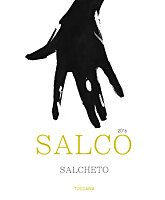
|
|
Vino Nobile di Montepulciano Salco 2016 |
|
| Salcheto (Tuscany, Italy) | |
 Sangiovese Sangiovese | |
| Price: € 38.50 | Score: |
 Intense ruby red and nuances of garnet red, little transparency. Intense ruby red and nuances of garnet red, little transparency. Intense, clean, pleasing, refined and elegant, starts with hints of
black cherry, plum and dried violet followed by aromas of dried rose,
blackberry, raspberry, blueberry, cinnamon, tobacco, cocoa, licorice,
leather, mace, vanilla and menthol. Intense, clean, pleasing, refined and elegant, starts with hints of
black cherry, plum and dried violet followed by aromas of dried rose,
blackberry, raspberry, blueberry, cinnamon, tobacco, cocoa, licorice,
leather, mace, vanilla and menthol.
 Properly tannic attack and however balanced by alcohol, full body,
intense flavors, agreeable. Properly tannic attack and however balanced by alcohol, full body,
intense flavors, agreeable.
 Very persistent finish with long flavors of black cherry, plum and
blackberry. Very persistent finish with long flavors of black cherry, plum and
blackberry.
 24 months in cask, 26 months in bottle. 24 months in cask, 26 months in bottle. |
|
 Game, Roasted meat, Stewed and braised meat, Hard cheese Game, Roasted meat, Stewed and braised meat, Hard cheese |
|
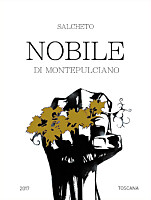
|
|
Vino Nobile di Montepulciano Vecchie Viti del Salco 2017 |
|
| Salcheto (Tuscany, Italy) | |
 Sangiovese Sangiovese | |
| Price: € 65.00 | Score: |
 Intense ruby red and nuances of garnet red, little transparency. Intense ruby red and nuances of garnet red, little transparency. Intense, clean, pleasing, refined and elegant, starts with hints of
plum, black cherry and dried violet followed by aromas of dried rose,
blackberry, blueberry, tobacco, cocoa, cinnamon, leather, mace, licorice,
vanilla and menthol. Intense, clean, pleasing, refined and elegant, starts with hints of
plum, black cherry and dried violet followed by aromas of dried rose,
blackberry, blueberry, tobacco, cocoa, cinnamon, leather, mace, licorice,
vanilla and menthol.
 Properly tannic attack and however balanced by alcohol, full body,
intense flavors, agreeable. Properly tannic attack and however balanced by alcohol, full body,
intense flavors, agreeable.
 Very persistent finish with flavors of plum, black cherry and
blackberry. Very persistent finish with flavors of plum, black cherry and
blackberry.
 2 years in cask, 2 years in bottle. 2 years in cask, 2 years in bottle. |
|
 Game, Roasted meat, Stewed and braised meat with mushrooms, Cheese Game, Roasted meat, Stewed and braised meat with mushrooms, Cheese |
|
News |
|
In this section are published news and information about events concerning the world of wine and food. Whoever is interested in publishing this kind of information can send us a mail to our address.
|
AquavitaeReview of Grappa, Distillates and Brandy |
|
|
||||||||||||
Wine Guide ParadeJanuary 2022
|
| |||||||
Privacy Policy | |||||||


| Copyright © 2002-2024 Antonello Biancalana, DiWineTaste - All rights reserved |
| All rights reserved under international copyright conventions. No part of this publication and of this WEB site may be
reproduced or utilized in any form or by any means, electronic or mechanical, without permission in writing from DiWineTaste. |